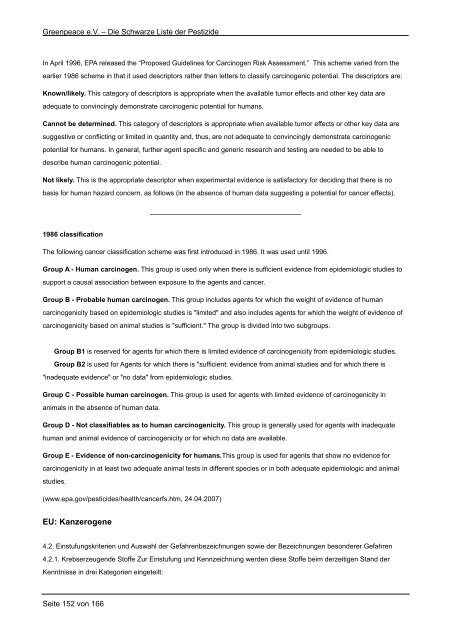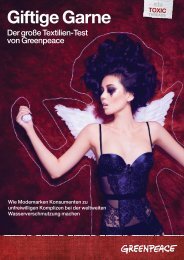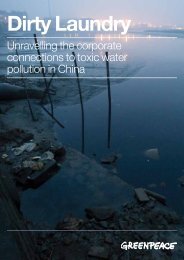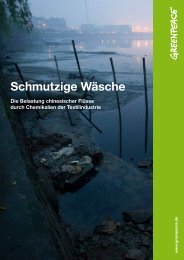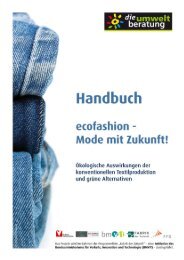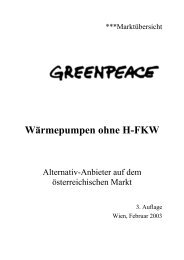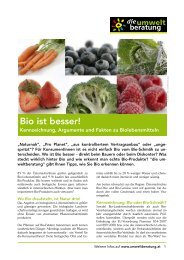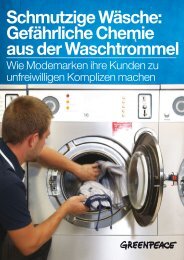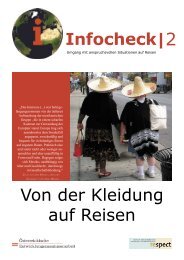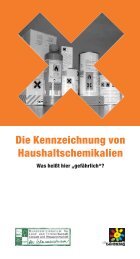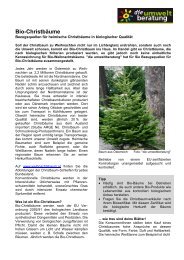Die Schwarze Liste der Pestizide - Greenpeace
Die Schwarze Liste der Pestizide - Greenpeace
Die Schwarze Liste der Pestizide - Greenpeace
Sie wollen auch ein ePaper? Erhöhen Sie die Reichweite Ihrer Titel.
YUMPU macht aus Druck-PDFs automatisch weboptimierte ePaper, die Google liebt.
<strong>Greenpeace</strong> e.V. – <strong>Die</strong> <strong>Schwarze</strong> <strong>Liste</strong> <strong>der</strong> <strong>Pestizide</strong><br />
In April 1996, EPA released the “Proposed Guidelines for Carcinogen Risk Assessment.” This scheme varied from the<br />
earlier 1986 scheme in that it used descriptors rather than letters to classify carcinogenic potential. The descriptors are:<br />
Known/likely. This category of descriptors is appropriate when the available tumor effects and other key data are<br />
adequate to convincingly demonstrate carcinogenic potential for humans.<br />
Cannot be determined. This category of descriptors is appropriate when available tumor effects or other key data are<br />
suggestive or conflicting or limited in quantity and, thus, are not adequate to convincingly demonstrate carcinogenic<br />
potential for humans. In general, further agent specific and generic research and testing are needed to be able to<br />
describe human carcinogenic potential.<br />
Not likely. This is the appropriate descriptor when experimental evidence is satisfactory for deciding that there is no<br />
basis for human hazard concern, as follows (in the absence of human data suggesting a potential for cancer effects).<br />
1986 classification<br />
The following cancer classification scheme was first introduced in 1986. It was used until 1996.<br />
Group A - Human carcinogen. This group is used only when there is sufficient evidence from epidemiologic studies to<br />
support a causal association between exposure to the agents and cancer.<br />
Group B - Probable human carcinogen. This group includes agents for which the weight of evidence of human<br />
carcinogenicity based on epidemiologic studies is "limited" and also includes agents for which the weight of evidence of<br />
carcinogenicity based on animal studies is "sufficient." The group is divided into two subgroups.<br />
Group B1 is reserved for agents for which there is limited evidence of carcinogenicity from epidemiologic studies.<br />
Group B2 is used for Agents for which there is "sufficient: evidence from animal studies and for which there is<br />
"inadequate evidence" or "no data" from epidemiologic studies.<br />
Group C - Possible human carcinogen. This group is used for agents with limited evidence of carcinogenicity in<br />
animals in the absence of human data.<br />
Group D - Not classifiables as to human carcinogenicity. This group is generally used for agents with inadequate<br />
human and animal evidence of carcinogenicity or for which no data are available.<br />
Group E - Evidence of non-carcinogenicity for humans.This group is used for agents that show no evidence for<br />
carcinogenicity in at least two adequate animal tests in different species or in both adequate epidemiologic and animal<br />
studies.<br />
(www.epa.gov/pesticides/health/cancerfs.htm, 24.04.2007)<br />
EU: Kanzerogene<br />
4.2. Einstufungskriterien und Auswahl <strong>der</strong> Gefahrenbezeichnungen sowie <strong>der</strong> Bezeichnungen beson<strong>der</strong>er Gefahren<br />
4.2.1. Krebserzeugende Stoffe Zur Einstufung und Kennzeichnung werden diese Stoffe beim <strong>der</strong>zeitigen Stand <strong>der</strong><br />
Kenntnisse in drei Kategorien eingeteilt:<br />
Seite 152 von 166


